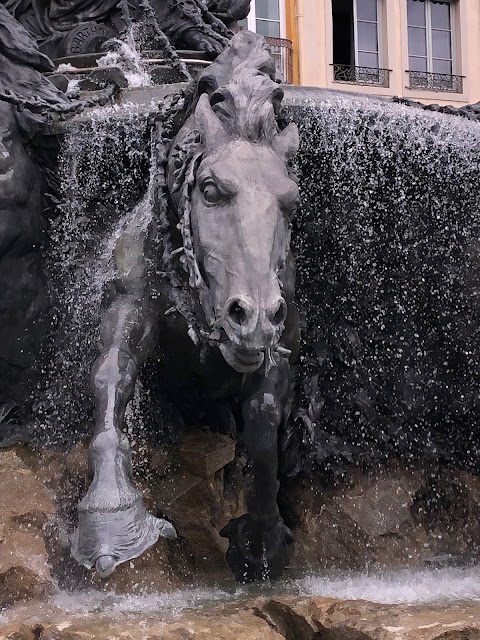 |
| One of France's mighty rivers--represented in Horse form, Place de Terraux. |
Lyon bills itself as France's culinary capital--most restaurants per capita, most Michelin stars in France (excepting Paris itself), serving traditional fare such as saucisse lyonnaise and quenelles de brochet Nantu (baked pike dumplings in a creamy langoustine sauce). And without exception, the food quality and dining experiences were outstanding.
The city had a harder time putting its best foot forward, though. We got off the high-speed rail at Gare Part-Dieu to quite a bit of street desperation--not quite East Oakland and nowhere near as desperate as downtown LA, but a bit surprising compared to most other places we've been in France so far. The Croix Rousse neighborhood, the historic center of the silk-making trade that was the source of Lyon's wealth for centuries, was covered in bad graffiti--and by bad, I mean random scrawlings, nothing that even attempted guerrilla art or murals and not even much in the way of political messages. At first glance it just seemed like the place had gone to seed and no one cared.
 |
| La Fontaine Bertholdi (designed by he of the Statue of Liberty) in Place des Terraux--representing four great rivers of France flowing into the see--is the standout feature of Croix Rousse. |
Which is a shame because for all their culinary bluster, civic pride and attempts to motivate tourism to their historic districts, Lyon seems like a city for the Lyonnais people. They have by far the best public transit system I've ever ridden--integrated, fast, extensive, clean and cheap. What more could any city want? The parks and public squares were full of people without seeming crowded or hectic. The Parc Naturel de la Feyssine, a beautiful open space along the Rhône river, provides the kind of unspoiled, uncrowded access to nature that Parisiens could only dream of in their grubby bois and manicured, rule-crazy parcs.
 |
| Orwellian-grade surveillance messages encourage good behavior on Lyon's metro. Translation: "Harassers: do you really think we can't see you?" |
So maybe the city's superficial disorder reflects trade-offs that favor locals rather than tourists. If a city doesn't have money for everything, maybe it cleans the graffiti less often and keeps the metro running a bit later.
What's great about Lyon for visitors? Besides the excellent food and the larger open spaces, the Renaissance-era old town (Vieux Lyon) was the location for the original silk manufacturers. It still has dense, cramped buildings with a lot a historical details remaining--including covered passages (traboules) that twist through buildings, allowing bolts of silk to be protected from the weather as they were moved from place to place. Narrow streets wind up a steep hill to Lyon's two best features: the Gallo-Roman amphitheater and the Basilique de Notre-Dame de Fourvière. There's also funicular used by commuters who don't want to walk or deal with stalled bus traffic up the hill (outshined by weaker competition again, San Francisco).
 |
| Along the back streets of Vieux Lyon. |
 |
| Overlooking Église de Sainte-Georges on the way up Fourvière hill. |
In a strange way, the amphitheater's upkeep undermines its attraction for someone expecting a historic ruin--which it is not, since it's still used as a venue for concerts and stage play. It was in such good condition that you could be convinced that, like the Greek Theater in Berkeley, it was built to evoke ancient arenas. Again, Lyon for the Lyonnaise, rather than for tourists. We wandered up and down the stone seating with the dog while kids played in the grass and climbed atop 2,000 year old marble columns without the park staff giving a second glance.
 |
Gallic playground equipment, circa 43 BCE.
|
 |
| A bloodthirsty Roman God? No just an exact replica of a death mask representing a wandering evil spirit, Jardin André Malreaux, Lyon. |
The neo-Byzantine le Basilique de Notre-Dame de Fourvière is without question the architectural jewel of Lyon. Built with funds from subscribers in the 1870s, the church honors the several miracles attributed to the BVM (Blessed Virgin Mary) on behalf of Lyon--including sparing the city from the devastation of both bubonic plague and cholera, and from invasion by the Prussian army during the Franco-Prussian war.
I've seen photos of the Basilique's interior by professional photographers--they do not do it justice, nor could any iPhone photos. It's completely unique among any of the grand churches, basilicas and cathedrals I've visited in Europe. Viewing the 19th century tile mosaic depicting "the heresies" was like entering a medieval illuminated manuscript, the teal and gold tiles absolutely glowing from the natural light and the candles. Other touches seemed comical (chickens?), puzzling (griffins and sphinxes?), or simply beyond my very limited grasp of christian theology (item: the altar depicts the BVM freeing Adam and Eve from hell, which is usually associated with her son's "harrowing" of hell).
So consider the following photos as akin to evidence provided in support of a near-death experience or UFO encounter. Even if someone believes the witness, their best efforts to convey what they saw will still be inadequate. You'll just have to see it for your self.
The exterior, on the other hand, is a bit more accessible, depicting some classics from the Old Testament--with a few twists.
 |
| David takes a trophy in his victory over Goliath. |
 |
| Jacob rassles an angel--call that one a draw. |
 |
| The BVM and a sphinx, under the rainbow. |





















Comments
Post a Comment